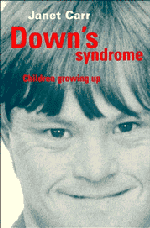Book contents
- Frontmatter
- Contents
- Acknowledgements
- 1 Down's syndrome – implications of the diagnosis
- 2 Populations and procedures
- 3 The developmental study
- 4 Self-care and independence
- 5 Behaviour and discipline
- 6 Focusing on the individual
- 7 Effect on the families
- 8 Help from services
- 9 Summary and conclusions
- References
- Index
1 - Down's syndrome – implications of the diagnosis
Published online by Cambridge University Press: 06 July 2010
- Frontmatter
- Contents
- Acknowledgements
- 1 Down's syndrome – implications of the diagnosis
- 2 Populations and procedures
- 3 The developmental study
- 4 Self-care and independence
- 5 Behaviour and discipline
- 6 Focusing on the individual
- 7 Effect on the families
- 8 Help from services
- 9 Summary and conclusions
- References
- Index
Summary
Down's syndrome is the most common, the most easily recognised and probably the most researched single condition causing learning disability. It was first identified by John Langdon Down in 1866; almost certainly it had existed long before that, possibly as far back as the seventh century (Brothwell 1960), while some sixteenth and seventeenth century paintings have depicted infants with ‘mongoloid features’ (Cone 1968; Zellweger 1968). Zellweger, however, warned of the dangers of accepting this kind of pictorial evidence, pointing out that the infant shown in one such painting later went on to become an admiral of the British Fleet. Richards (1968) suggested that the condition may indeed have been rarer in the past because of smaller populations and higher rates of infant and maternal mortality, and the fact that in the mid-nineteenth century only 58% of women survived to the age of 35, which, as this is the high risk age for mothers of Down's syndrome babies, would have reduced the incidence at that time.
Down (1866) expounded his theory that many of the patients he saw, both in the Earlswood Asylum and as out-patients, could be identified as belonging to one or other of the ethnic groups: Caucasian, Ethiopian, Malayan, from the South Sea Islands and from the American continent.
- Type
- Chapter
- Information
- Down's SyndromeChildren Growing Up, pp. 1 - 14Publisher: Cambridge University PressPrint publication year: 1995
- 1
- Cited by



